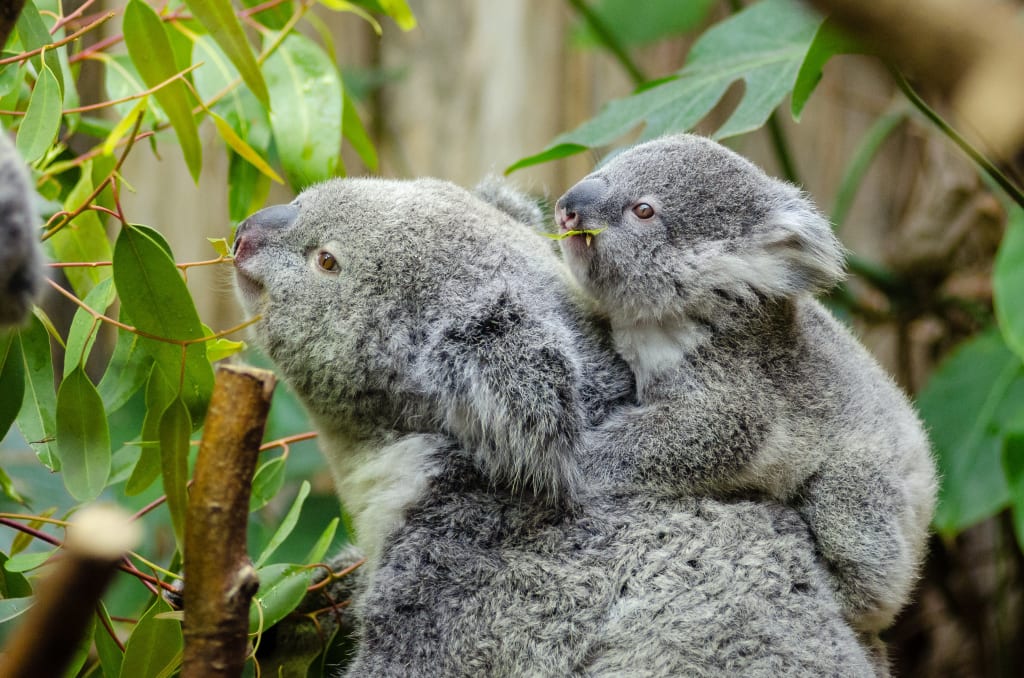
The koala, an iconic symbol of Australia, is a fascinating marsupial known for its distinctive appearance, unique behaviors, and specialized diet. Here, we delve into the captivating world of koalas, exploring their biology, ecology, conservation status, and their significance in Australian culture.
Biology and Physiology
Koalas (Phascolarctos cinereus) are arboreal marsupials native to Australia. Despite their bear-like appearance, they are not bears but belong to the marsupial family. They are often referred to as "koala bears" due to their resemblance to teddy bears. Koalas have a distinctive appearance, characterized by fluffy ears, a stout body, a large nose, and thick, woolly fur, which helps them regulate body temperature and provides protection against harsh weather conditions.
One of the most intriguing aspects of koalas is their diet. They are specialized folivores, primarily feeding on the leaves of eucalyptus trees. Eucalyptus leaves are low in nutrition and contain toxins that would be harmful to most animals. However, koalas have evolved specialized digestive systems to detoxify these leaves efficiently. Their digestive tract is adapted to break down the tough, fibrous leaves, extracting the nutrients while minimizing the intake of toxins.
Koalas have a unique relationship with eucalyptus trees, as they rely almost exclusively on these trees for food, shelter, and habitat. They are highly selective in their choice of eucalyptus species and typically feed on a few preferred varieties out of the hundreds of eucalyptus species found in Australia.
Behavior and Ecology
Koalas are solitary and territorial animals, with each individual occupying a home range that overlaps with those of other koalas. They are primarily nocturnal, spending most of their day sleeping in the safety of eucalyptus trees. Koalas are adept climbers, using their strong limbs and sharp claws to ascend trees and navigate through the branches with ease. They have a slow metabolic rate, which helps conserve energy, especially given their low-nutrient diet.
During the breeding season, which typically occurs from September to March, male koalas establish dominance hierarchies and compete for access to females. Female koalas give birth to a single offspring known as a joey, which is born undeveloped and completes its development in the mother's pouch. The joey stays in the pouch for around six months, gradually transitioning to riding on its mother's back until it becomes independent at around one year old.
Koalas play a crucial role in their ecosystems as seed dispersers and habitat engineers. By feeding on eucalyptus leaves and dispersing seeds through their droppings, they contribute to the regeneration and diversity of eucalyptus forests. Additionally, their browsing behavior helps shape the structure of tree canopies, influencing the composition of plant communities within their habitat.
Conservation Status and Threats
Despite their cultural significance and popularity, koalas face numerous threats to their survival, primarily driven by habitat loss, fragmentation, and climate change. The clearing of land for agriculture, urban development, and logging has resulted in the loss of large areas of koala habitat, limiting their access to suitable food and shelter. Habitat fragmentation also increases the risk of isolation among koala populations, reducing genetic diversity and making them more vulnerable to disease and other threats.
Climate change poses additional challenges for koalas, as rising temperatures and altered weather patterns affect the distribution and abundance of eucalyptus trees, their primary food source. Extreme weather events such as heatwaves, droughts, and wildfires can lead to mass die-offs of eucalyptus trees and exacerbate food shortages for koalas.
In addition to habitat loss and climate change, koalas are also threatened by disease, predation, vehicle collisions, and domestic dog attacks. Chlamydia, a bacterial infection, is a significant health concern for koalas and can cause reproductive problems, blindness, and death if left untreated.
Conservation Efforts and Initiatives
Efforts to conserve and protect koalas involve a combination of habitat conservation, land management practices, research, education, and community engagement. Conservation organizations and government agencies work together to identify and protect critical koala habitats, establish wildlife corridors to connect fragmented populations, and implement measures to mitigate the impacts of climate change and other threats.
Community involvement and public awareness are essential components of koala conservation efforts, as local communities play a vital role in monitoring koala populations, reporting sightings, and participating in habitat restoration projects. Educational programs aimed at raising awareness about koala conservation issues help foster appreciation for these iconic marsupials and encourage sustainable practices that support their survival.
Research into koala biology, ecology, behavior, and genetics provides valuable insights into their conservation needs and informs management strategies aimed at enhancing their long-term viability. Captive breeding programs and rehabilitation centers play a crucial role in rescuing and caring for injured, sick, or orphaned koalas, with the ultimate goal of releasing them back into the wild.
In conclusion, koalas are remarkable creatures with a rich evolutionary history and a complex relationship with their environment. As symbols of Australia's unique biodiversity, they capture the imagination and inspire conservation efforts aimed at ensuring their survival for future generations to appreciate and cherish. Through collaborative action and collective stewardship, we can protect and preserve the precious legacy of koalas and safeguard the ecosystems they inhabit.
Thanks.






Comments
There are no comments for this story
Be the first to respond and start the conversation.